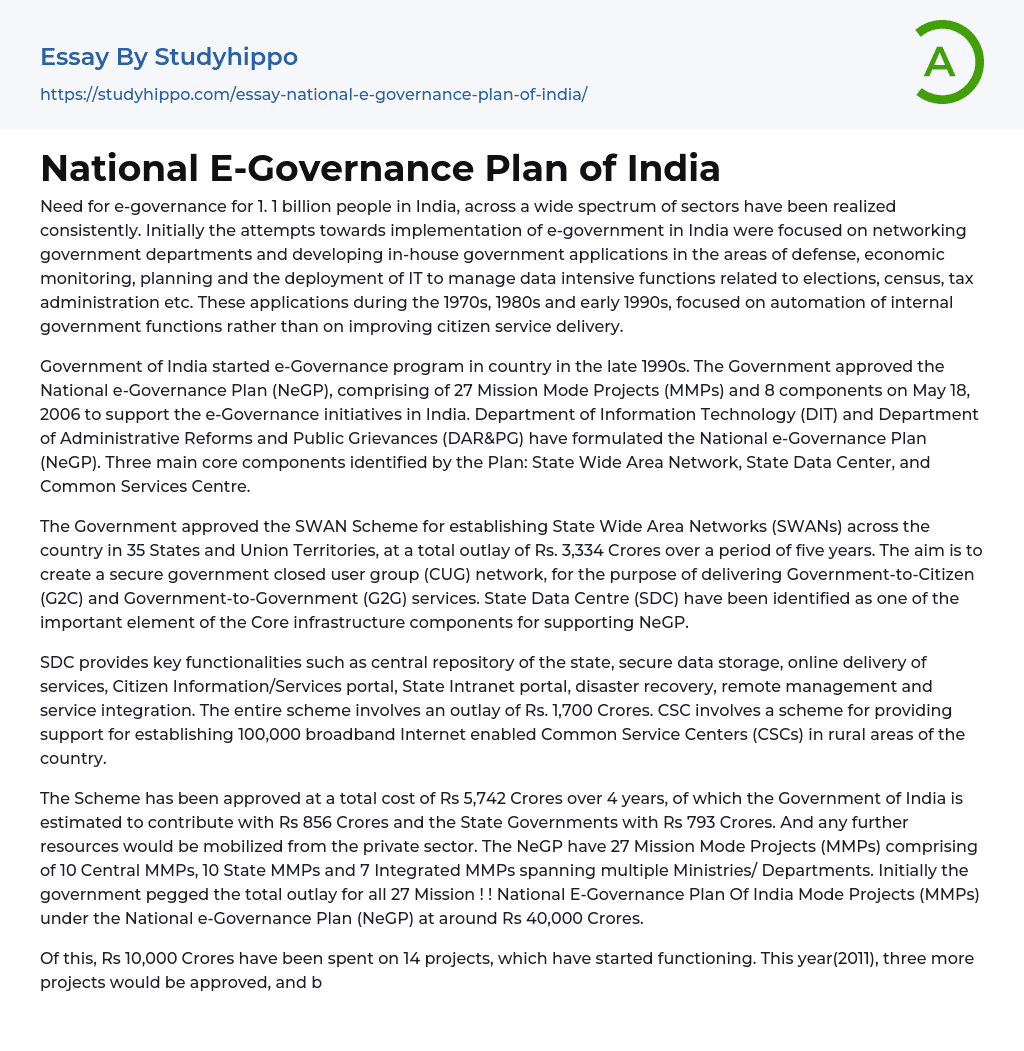In India, the recognition of the need for e-governance has remained consistent considering its vast population of 1.1 billion people and various industries. Initially, the focus was on connecting government departments and developing applications for defense, economy monitoring, planning, elections, census, tax administration, and other data-driven tasks using IT. However, during the 1970s to early 1990s, these efforts primarily aimed at automating internal government processes rather than emphasizing improved citizen service delivery.
In the late 1990s, the Government of India launched the e-Governance program. On May 18, 2006, they approved the National e-Governance Plan (NeGP). The NeGP comprises of 27 Mission Mode Projects (MMPs) and 8 components dedicated to supporting e-Governance initiatives in India. The NeGP was formulated by the Department of Information Technology (DIT) and the Department of Administrative Re
...forms and Public Grievances (DAR&PG). They identified three core components for this plan: State Wide Area Network, State Data Center, and Common Services Centre.
The SWAN Scheme, approved by the Government, aims to establish State Wide Area Networks (SWANs) in 35 States and Union Territories across the country. With a budget of Rs. 3,334 Crores, this scheme will be implemented over five years. Its objective is to create a secure government closed user group (CUG) network that will facilitate the delivery of Government-to-Citizen (G2C) and Government-to-Government (G2G) services. Additionally, the State Data Centre (SDC) has been identified as a crucial component of the Core infrastructure for supporting NeGP.
The SDC provides several important features such as a central repository, secure data storage, online service delivery, a portal for citizen information and services, a state intranet portal, disaster recovery, remote management, and service
integration. The total cost of the scheme amounts to Rs. 1,700 Crores. The CSC's goal is to establish 100,000 broadband-enabled Common Service Centers (CSCs) in rural areas of the country.The approved Scheme for the National E-Governance Plan (NeGP) in India will have a total cost of Rs 5,742 Crores over 4 years. The Government of India's contribution will be Rs 856 Crores and the State Governments' contribution will be Rs 793 Crores. Additional resources will be obtained from the private sector. The NeGP consists of 27 Mission Mode Projects (MMPs), which include 10 Central MMPs, 10 State MMPs, and 7 Integrated MMPs involving multiple Ministries/Departments. Initially, the government estimated that the total outlay for all 27 Mission Mode Projects under the NeGP would amount to approximately Rs 40,000 Crores.
A total of Rs 10,000 Crores has been spent on 14 operational projects. In addition, three more projects will be approved in 2011 and it is anticipated that all projects will begin offering services by 2014. The overall budget for the MMPs, covering both capital and operating expenses, falls within the range of Rs 30,000 to Rs 40,000 Crores. Currently, Rs 10,000 Crores has been used for activities including the digitization of government records and making them available to citizens through various access centers.
Significant funds have been allocated for the development of the core infrastructure under the National e-Governance Plan, and it is expected that all remaining projects will be live by 2014. A major milestone in this direction was the establishment of information and communication-technology enabled Common Services Centers (CSCs) at the village level. Through public-private partnerships, around 47,000 CSCs have been
set up across the country with participation from large corporates. These centers provide government services to rural communities at any time. It is predicted that by the end of 2011, India will have 24 million rural internet users.
The growth of internet users in rural India is attributed to the maturity of government initiatives facilitated by the National eGovernance Plan (NeGP), according to a report. The National Portal of India, which is an integral part of the NeGP implemented by the National Informatics Center, is classified as a Mission Mode Project.
The Portal aims to offer thorough, precise, and trustworthy information about India and its diverse aspects. It has effectively organized the information into separate modules, which are also interconnected in relevant sections to provide visitors with a comprehensive perspective. The government intends to utilize the private-public partnership model for implementing projects under NeGP, presenting multiple opportunities for vendors.
According to minutes of NeGP Review Meeting held at Lakshadweep on 10. 12. 2010, the Honorable Administrator ordered the establishment of LAN in various offices including Electricity, Animal Husbandry, Medical ; Health, Fisheries, Education, Tourism, Co-operational, Panchayat, and Port. This demonstrates the success of the NeGP initiative by the government of India in strengthening its governance system over the years.
- Cloud Computing essays
- Computer Science essays
- Consumer Electronics essays
- Data Analysis essays
- Electronics essays
- engineering essays
- Enterprise Technology essays
- Hardware essays
- Impact of Technology essays
- Information Age essays
- Information Technology essays
- Modern Technology essays
- Operating Systems essays
- people search essays
- Robot essays
- Activism essays
- Communism essays
- Conservatism essays
- Liberalism essays
- Marxism essays
- Nationalism essays
- Patriotism essays
- Policy essays
- Public Policy essays
- Social Contract essays
- Socialism essays
- Totalitarianism essays
- Network Topology essays
- Telecommunication essays
- Telecommunications essays




